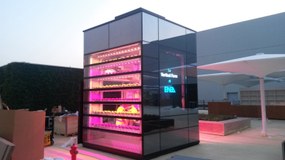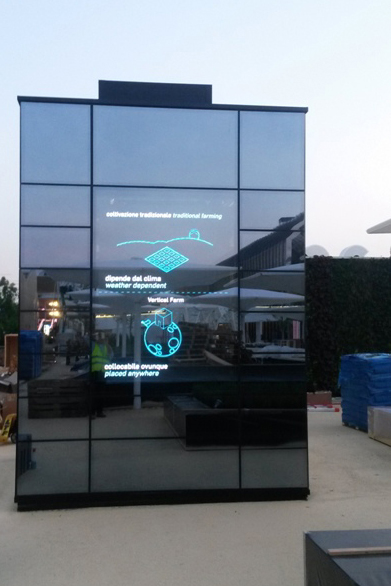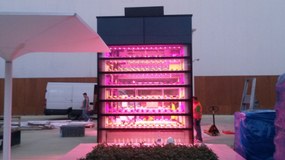EXPO 2015: ENEA’s ‘vertical farm’ at the Future Food District
25/5/2015
30 technologies in the ENEA showcase for agro-food SMEs, dedicated to process and product eco-innovation, waste recycling, food traceability and safety.
 From sensors for food sophistication to food traceability, from biopharmaceuticals to eco-packaging, from water-grown plants to natural pesticides. Also, green energy produced by way of concentrating solar collectors, agro-food waste recycling for biofuel production and projects to farm arid lands in the African continent. These are just a few of the ENEA eco-friendly technologies, dedicated to agro-food enterprises and international cooperation, and presented at EXPO 2015.
From sensors for food sophistication to food traceability, from biopharmaceuticals to eco-packaging, from water-grown plants to natural pesticides. Also, green energy produced by way of concentrating solar collectors, agro-food waste recycling for biofuel production and projects to farm arid lands in the African continent. These are just a few of the ENEA eco-friendly technologies, dedicated to agro-food enterprises and international cooperation, and presented at EXPO 2015.
Our password for EXPO is: putting innovative technologies and services at the disposal of all the Italian enterprises, especially SMEs, in order to increase the competitiveness of an ever sustainable agro-industrial system by optimizing the use of water, land and energy resources – says Federico Testa, Commissioner of ENEA – All this by putting a strong focus also on technology transfer through international cooperation and sustainable technologies capable of contributing to address the huge problem posed by Milan’s Expo: feeding the entire Planet.
 ENEA’s presence in Milan will be in the spotlight through the Vertical Farm, the first Italian prototype of vertical greenhouse exhibited within the Future Food District, where visitors will be able to experiment futuristic food scenarios.
ENEA’s presence in Milan will be in the spotlight through the Vertical Farm, the first Italian prototype of vertical greenhouse exhibited within the Future Food District, where visitors will be able to experiment futuristic food scenarios.
The Vertical Farm is a unique place where new technologies change the way of producing foods, setting new standards in five areas of scientific research and technology transfer to agro-industry: land, water, energy, sustainable agriculture and safe food. ENEA’s vertical farm means zero land – since vegetables do not need any soil to grow but rather water and nutrients only (the so-called hydroponic system) – but also zero pesticides, zero emissions, and zero wastes. Also, total recycling of fertilizers and water, as well as green and efficient energy, thanks to the use of renewable energy sources, the conversion of wastes into resources, food traceability and safety. Actually, a synthesis of scientific research and technology transfer to the agro-industrial system.
Producing soil-free food products represents an important challenge at the global but for Italy too, which has lost more than 6 million hectares of farms over the last six decades. It is estimated that, to date, 70% of the global water consumption is due to cultivations and livestock farming, whereas almost one billion people have no access to drinking water and one billion people suffers from malnutrition.
Compared with the whole energy consumed worldwide, the energy used by the food chain is about 30% against two and a half billion people who do not have any access to all novel forms of energy. And these challenges will increase in the future, since competition for food, water and energy is bound to inevitably increase due to population growth, economic development and climate change. Actually, the OECD estimates that by 2050 the global demand for energy and water will increase by 80% and 55%, respectively; by the same period, FAO estimates that food demand will rise by 60%.
 These are the themes at the focus of specific EXPO 2015 initiatives, too, such as the meeting A biodiverse world: agro-diversity in a changing world, held last May 6, during which ENEA researchers have focused the debate on climate change, invasive species – for example, those currently infesting vines and olive trees in Italy - and the role of farmers as key actors of a safe and sustainable food production. Another event, to be held on May 14, will see ENEA experts debate on the Mediterranean diet, whereas on May 21 the seminar “Nexus – Food, Water and Energy” will take place, dedicated to adopting a systemic approach for themes related to resource availability, accessibility, distribution and sustainability.
These are the themes at the focus of specific EXPO 2015 initiatives, too, such as the meeting A biodiverse world: agro-diversity in a changing world, held last May 6, during which ENEA researchers have focused the debate on climate change, invasive species – for example, those currently infesting vines and olive trees in Italy - and the role of farmers as key actors of a safe and sustainable food production. Another event, to be held on May 14, will see ENEA experts debate on the Mediterranean diet, whereas on May 21 the seminar “Nexus – Food, Water and Energy” will take place, dedicated to adopting a systemic approach for themes related to resource availability, accessibility, distribution and sustainability.
Eventually, “Rome will get closer to Milan” thanks to an ideal EXPO 2015-centred pathway, set up in the laboratories of Casaccia, the largest ENEA research centre. International delegations will first-hand experience the ENEA technologies presented in Milan, accessing the laboratories which made the history of Italian agro-food research, starting from creso wheat in the ‘70s, and are still tracking its future with clear-cut sustainability and innovation objectives.
For further information, please contact:
Massimo Iannetta, Casaccia Research Centre, massimo.iannetta@enea.it
Gabriella Funaro, Casaccia Research Centre, gabriella.funaro@enea.it
